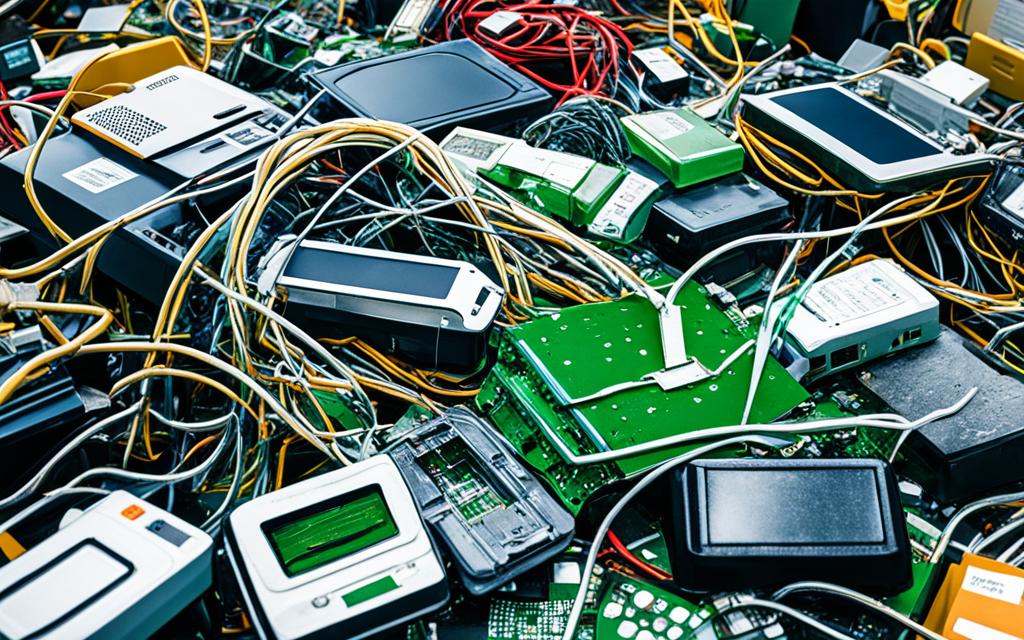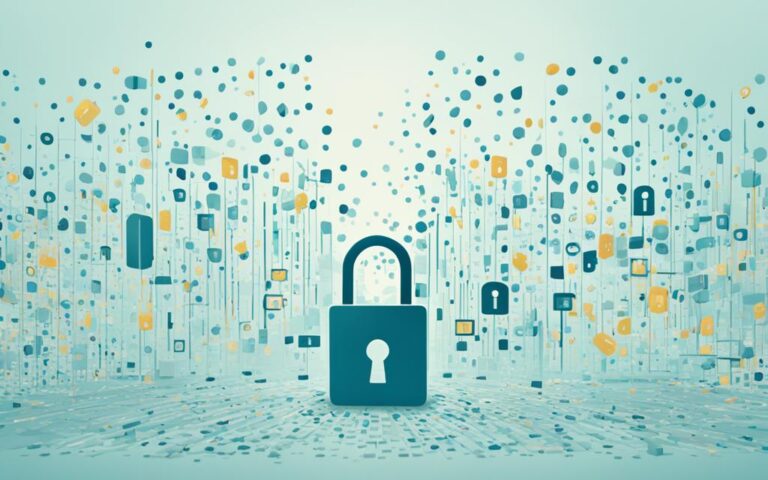Navigating the Complex Landscape of IT Asset Disposal Regulations
Proper disposal of IT assets and electronic waste, also known as e-waste, is essential in today’s digital age. Not only does it help protect the environment, but it also ensures the efficient use of valuable resources. In the United Kingdom, businesses and organizations must navigate the intricate web of IT asset disposition regulations to comply with Waste Electrical and Electronic Equipment (WEEE) guidelines.
At every stage of the IT lifecycle, from acquisition to retirement, companies need to adopt best practices for IT Asset Disposition (ITAD). Compliance with UK disposal regulations is crucial for the responsible handling, recycling, and disposal of electronic waste.
By understanding and adhering to these regulations, businesses can minimize environmental impact, extract maximum value from their IT assets, and contribute to a sustainable future. Let’s explore the importance of responsible IT asset disposal and the benefits of compliance with WEEE regulations.
The Importance of Responsible IT Asset Disposal
E-waste encompasses a wide array of discarded electronic devices, including computers, smartphones, and televisions. Proper electronic recycling plays a vital role in extracting value from e-waste. By recycling e-waste through reputable IT asset disposal companies, businesses can ensure the recovery of valuable materials and reduce the need for extracting new raw materials.
Electronic recycling not only prevents hazardous materials from polluting the environment but also fosters resource conservation through the retrieval of valuable components. By responsibly recycling e-waste, businesses contribute to the sustainable extraction of resources and minimize the environmental impact of electronic waste disposal.
“Recycling one million laptops saves the energy equivalent to the electricity used by more than 3,500 US homes in a year. It also reduces greenhouse gas emissions equivalent to those produced by over 1,000 cars annually.”
In addition to conserving resources and preventing pollution, responsible IT asset disposal enables the extraction of valuable materials. Electronic devices contain precious metals such as gold, silver, and palladium. Recycling e-waste through experienced IT asset disposal companies ensures the recovery of these valuable resources, reducing the need for extracting new raw materials.
A reputable IT asset disposal provider like S2S Group employs secure and environmentally friendly electronic recycling practices. By partnering with such companies, businesses can contribute to resource conservation efforts and ensure the proper handling and disposal of e-waste.
Through responsible IT asset disposal, businesses not only fulfill their environmental obligations but also optimize value extraction from e-waste. By embracing electronic recycling and engaging with trusted IT asset disposal providers, companies demonstrate their commitment to resource conservation and environmental sustainability.
Compliance with WEEE Regulations
Proper handling, disposal, and recycling practices of electronic waste are crucial to mitigate environmental risks and promote sustainable practices in the IT industry. Compliance with Waste Electrical and Electronic Equipment (WEEE) regulations is essential for businesses and organizations involved in IT asset disposal. These regulations govern the management and recycling of e-waste, ensuring that it is handled responsibly and in accordance with environmental standards.
Adhering to WEEE regulations not only helps protect the environment but also contributes to electronic recycling efforts. By ensuring compliance with these regulations, businesses can make a positive impact by reducing e-waste and promoting the sustainable use of resources.
To comply with WEEE regulations, businesses and organizations should follow best practices for the proper handling, disposal, and recycling of electronic waste. This includes:
- Segregating e-waste from other types of waste to facilitate proper recycling
- Partnering with certified IT asset disposal companies that comply with WEEE regulations
- Implementing secure data destruction methods to protect sensitive information
- Maintaining proper documentation of the disposal process to demonstrate compliance
By adhering to WEEE regulations, businesses can minimize environmental risks, ensure the proper recycling of e-waste, and contribute to sustainable practices that support a greener IT industry.
Benefits of Compliance with WEEE Regulations:
Complying with WEEE regulations offers several benefits for businesses and the environment:
“Proper compliance with WEEE regulations ensures that electronic waste is handled responsibly, minimizing environmental risks and promoting sustainable practices in the IT industry.” – David Smith, Environmental Compliance Expert
| Benefits | Description |
|---|---|
| Environmental Protection | Compliance with WEEE regulations helps prevent the improper disposal of electronic waste, reducing pollution and conserving natural resources. |
| Legal Compliance | By adhering to WEEE regulations, businesses fulfill their legal obligations and mitigate the risk of penalties and reputational damage. |
| Sustainable Practices | Compliance with WEEE regulations promotes sustainable practices in the IT industry by encouraging the proper handling, recycling, and reuse of electronic waste. |
| Resource Conservation | Proper recycling of e-waste allows for the recovery of valuable materials, reducing the need for extracting new raw materials from the environment. |
| Economic Opportunities | Complying with WEEE regulations can open doors to new business opportunities related to IT asset disposal, recycling, and environmental consulting. |
By prioritizing WEEE compliance and implementing proper handling, disposal, and recycling practices, businesses can make a significant contribution to environmental conservation and the sustainable future of the IT industry.
The Benefits of Responsible IT Asset Disposal
One of the significant benefits of responsible IT asset disposal is the recovery of valuable materials. Electronic devices contain precious metals like gold, silver, and palladium, which can be extracted and reused.
Recycling e-waste through experienced IT asset disposal companies ensures that valuable resources are not lost but instead repurposed, reducing the need for extracting new raw materials. By recycling their electronic waste responsibly, businesses and organizations can contribute to sustainable practices and maximize value recovery.
Proper disposal of electronic waste helps conserve natural resources and reduce the environmental impact of extracting precious metals from the Earth. It also plays a crucial role in preventing the accumulation of electronic waste and the associated environmental risks.
IT asset disposal companies specialize in extracting valuable materials from electronic devices through efficient and environmentally friendly processes. These companies have the expertise and technology to recover and recycle precious metals, ensuring that valuable resources are not wasted.
Value Recovery through IT Asset Disposal
Recycling e-waste through reputable IT asset disposal companies allows businesses to maximize value recovery. By extracting and repurposing precious metals, organizations can reduce their reliance on mining new raw materials while contributing to a more sustainable economy. It’s a win-win situation where businesses benefit financially while promoting environmental conservation.
Electronic devices are rich in valuable materials and precious metals that can be costly to extract from the Earth. IT asset disposal companies utilize specialized techniques to recover these materials and extract their maximum value.
Through the responsible recycling of electronic waste, businesses and organizations can help mitigate the environmental impact of traditional mining practices, reduce their carbon footprint, and contribute to a more circular economy.
Choosing to work with reputable IT asset disposal companies ensures that valuable materials are effectively recovered and repurposed, minimizing waste and promoting resource conservation. It also enables businesses to comply with regulatory requirements and demonstrate their commitment to sustainable business practices.
Maximizing Value Recovery and Environmental Conservation
Responsible IT asset disposal offers a dual benefit of maximizing value recovery and contributing to environmental conservation. By recycling electronic waste and recovering valuable materials, businesses and organizations play a crucial role in reducing the demand for new raw materials and minimizing the environmental footprint associated with resource extraction.
Furthermore, sustainable practices in IT asset disposal align with global efforts to combat climate change and reduce carbon emissions. By choosing responsible IT asset disposal options, businesses can significantly reduce greenhouse gas emissions, energy consumption, and overall environmental impact.
“By recycling electronic waste responsibly, businesses and organizations can maximize value recovery, reduce reliance on new raw materials, contribute to a circular economy, and protect the environment for future generations.”
Choosing a Trusted IT Asset Disposal Provider
When it comes to responsible electronic waste recycling, selecting a trusted IT asset disposal company is of utmost importance. Businesses need to ensure that their chosen provider has the expertise in secure data destruction and environmentally friendly recycling practices.
An industry-leading IT asset disposal company like S2S Group not only helps businesses navigate the complex landscape of IT asset disposal but also ensures compliance with regulations and maximizes value recovery. By partnering with a reputable provider, businesses can make a positive impact on the environment while safeguarding their data and reputation.
S2S Group prioritizes secure data destruction to protect businesses from potential data breaches and ensure compliance with data protection laws. With advanced data erasure techniques and secure disposal methods, they guarantee that sensitive information is permanently destroyed and cannot be recovered.
“Choosing a trusted IT asset disposal provider is crucial for responsible electronic waste recycling. By partnering with a reputable provider, businesses can make a positive impact on the environment while safeguarding their data and reputation.”
Environmental practices are another vital aspect to consider when selecting an IT asset disposal company. S2S Group follows stringent environmental standards and practices to minimize the impact of electronic waste on the planet. They prioritize sustainable recycling methods and adhere to strict regulations to ensure responsible electronic waste recycling.
By choosing S2S Group or a similar trusted provider, businesses can successfully address the challenges of IT asset disposal, confidently comply with regulations, and contribute to a more sustainable future.
Why Choose S2S Group?
- Expertise in secure data destruction and environmentally friendly recycling practices.
- Compliance with regulations for responsible electronic waste recycling.
- Advanced data erasure techniques for secure data destruction.
- Strict adherence to environmental standards and sustainable recycling practices.
- A track record of successfully assisting businesses in IT asset disposal.
Legal Compliance in IT Asset Disposition
Legal compliance is a critical aspect of IT asset disposition. Businesses must adhere to data protection laws, such as the General Data Protection Regulation (GDPR) and the Health Insurance Portability and Accountability Act (HIPAA), to ensure the secure deletion of data and prevent unauthorized access to personal and sensitive information. Compliance with these laws is essential for maintaining customer trust and avoiding costly legal consequences.
Furthermore, environmental compliance is another crucial component of IT asset disposition. Regulations like the Waste Electrical and Electronic Equipment (WEEE) Directive govern the proper handling, recycling, and disposal of electronic waste. It is essential for businesses to prioritize environmental compliance to minimize the negative impact of electronic waste on the environment and human health.
To achieve legal compliance in IT asset disposition, businesses need to be knowledgeable about the relevant legal requirements. They must adjust their IT asset disposition strategies to align with these laws and regulations. This includes implementing secure data deletion processes, adopting environmentally responsible recycling practices, and ensuring proper documentation and record-keeping.
Adherence to Standards
In addition to legal requirements, businesses should also adhere to industry standards and best practices for IT asset disposition. Compliance with standards such as the National Association for Information Destruction (NAID) Standards and the Responsible Recycling (R2) Standard ensures that IT asset management companies follow established protocols for data destruction and environmental responsibility. Working with IT asset disposal providers that adhere to these standards provides businesses with the assurance that their assets will be handled in a responsible and compliant manner.
“Legal compliance and adherence to data protection and environmental regulations are essential for businesses to minimize risks, safeguard sensitive information, and protect the environment.”
Overall, legal compliance plays a crucial role in IT asset disposition. Businesses must comply with data protection laws, environmental regulations, and industry standards to ensure secure data deletion, protect sensitive information, and minimize the impact of electronic waste on the environment. By partnering with knowledgeable and compliant IT asset disposal providers, businesses can navigate the complex landscape of legal requirements and achieve a successful and responsible IT asset disposition.
Documentation and Record-Keeping in IT Asset Disposition
Effective documentation and record-keeping are vital aspects of proper IT asset disposition. By maintaining comprehensive asset inventories, businesses can accurately track the lifecycle of their IT assets and make informed decisions regarding their disposition. This ensures that assets are handled appropriately at each stage, from procurement to disposal.
“Accurate and detailed asset inventories provide a complete view of the organization’s IT assets, allowing for better planning and decision-making.”
Furthermore, obtaining and preserving data destruction certificates is crucial for demonstrating compliance with data protection laws. These certificates serve as tangible proof that the necessary measures were taken to securely destroy sensitive information stored on the assets being disposed of. They also safeguard organizations from potential legal and reputational risks.
“Data destruction certificates provide legal protection and instill trust in clients and stakeholders, showcasing commitment to data security.”
Regular compliance audits play a vital role in maintaining legal compliance in ITAD. These audits assess whether an organization’s IT asset disposition processes align with industry standards and certifications. By conducting these audits periodically, businesses can identify any gaps or areas for improvement in their processes, ensuring that they remain up-to-date and in compliance with relevant regulations.
“Compliance audits provide a proactive approach to risk management, ensuring alignment with changing regulations and industry best practices.”
Employee training is also an indispensable component of effective IT asset disposition. Adequately trained employees understand the importance of compliance, proper handling of assets, and the significance of documentation and record-keeping. By providing regular training sessions, organizations ensure that their staff members are equipped with the necessary knowledge and skills to make informed decisions and execute proper IT asset disposition practices.
“Investing in employee training fosters a culture of compliance, instilling best practices for IT asset disposition throughout the organization.”
| Key Elements of Documentation and Record-Keeping in IT Asset Disposition | Benefits |
|---|---|
| Asset inventories | – Comprehensive view of IT assets |
| Data destruction certificates | – Proof of compliance with data protection laws – Legal protection and trust-building |
| Compliance audits | – Proactive risk management – Alignment with regulations and industry best practices |
| Employee training | – Foster a culture of compliance – Implementation of best practices |
By implementing thorough documentation and record-keeping practices, businesses and organizations can ensure legal compliance, mitigate risks, and maintain a secure and efficient IT asset disposition process.
Conclusion
Navigating the complex landscape of IT asset disposition requires businesses and organizations to adopt best practices, comply with regulations, and work with trusted IT asset disposal providers. By following ITAD best practices, businesses can ensure the responsible disposal of their electronic waste, maximizing value recovery while minimizing environmental impact. Compliance with legal regulations, such as WEEE compliance for proper handling and recycling of e-waste, is essential for maintaining legal compliance and protecting the environment.
Responsible IT asset disposal not only contributes to environmental conservation efforts but also enables businesses to recover valuable resources. Recycling electronic waste through reputable IT asset disposal companies allows for the extraction and reuse of valuable materials, reducing the need for extracting new raw materials and promoting resource conservation. By choosing a trusted IT asset disposal provider like S2S Group, businesses can make a positive impact on the environment while ensuring secure data destruction and protecting their brand reputation.
Moreover, incorporating legal compliance, documentation, and record-keeping practices is crucial in IT asset disposition. Adhering to data protection laws such as GDPR and HIPAA is necessary to secure sensitive data and prevent unauthorized access. Maintaining detailed asset inventories, obtaining data destruction certificates, and conducting compliance audits ensure transparency and assist in meeting legal requirements. By embracing these practices, businesses can effectively manage their IT assets throughout their lifecycle while maintaining legal compliance and contributing to a sustainable future.
FAQ
What is IT asset disposition (ITAD)?
ITAD refers to the process of properly disposing of IT assets such as computers, smartphones, and televisions. It involves secure data destruction and environmentally friendly recycling practices.
What are UK disposal regulations for IT asset disposal?
UK disposal regulations include the Waste Electrical and Electronic Equipment (WEEE) regulations, which govern the management and recycling of electronic waste to ensure proper handling, disposal, and recycling practices.
Why is responsible IT asset disposal important?
Responsible IT asset disposal prevents hazardous materials from contaminating the environment and promotes resource conservation by recovering valuable components from e-waste.
How can compliance with WEEE regulations benefit businesses?
Compliance with WEEE regulations helps protect the environment and promotes sustainable practices in the IT industry. It ensures proper handling, disposal, and recycling of electronic waste.
What are the benefits of responsible IT asset disposal?
Responsible IT asset disposal allows for the recovery of valuable materials, such as precious metals like gold, silver, and palladium, reducing the need for extracting new raw materials.
How can businesses choose a trusted IT asset disposal provider?
Businesses should look for IT asset disposal companies with expertise in secure data destruction and environmentally friendly recycling practices. Companies like S2S Group can provide industry-leading services.
What legal compliance is required in IT asset disposition?
Businesses need to adhere to data protection laws like GDPR and HIPAA to ensure secure data deletion. They also need to comply with environmental regulations such as the WEEE Directive for proper handling, recycling, and disposal of electronic waste.
Why is documentation and record-keeping important in IT asset disposition?
Documentation and record-keeping, including detailed asset inventories and data destruction certificates, help track the lifecycle of IT assets, ensure compliance with data protection laws, and facilitate regular compliance audits and employee training.
What is the importance of IT asset disposal best practices?
IT asset disposal best practices, including legal compliance, maximize value recovery, protect the environment by preventing improper disposal of e-waste, and contribute to sustainable IT asset lifecycles.















